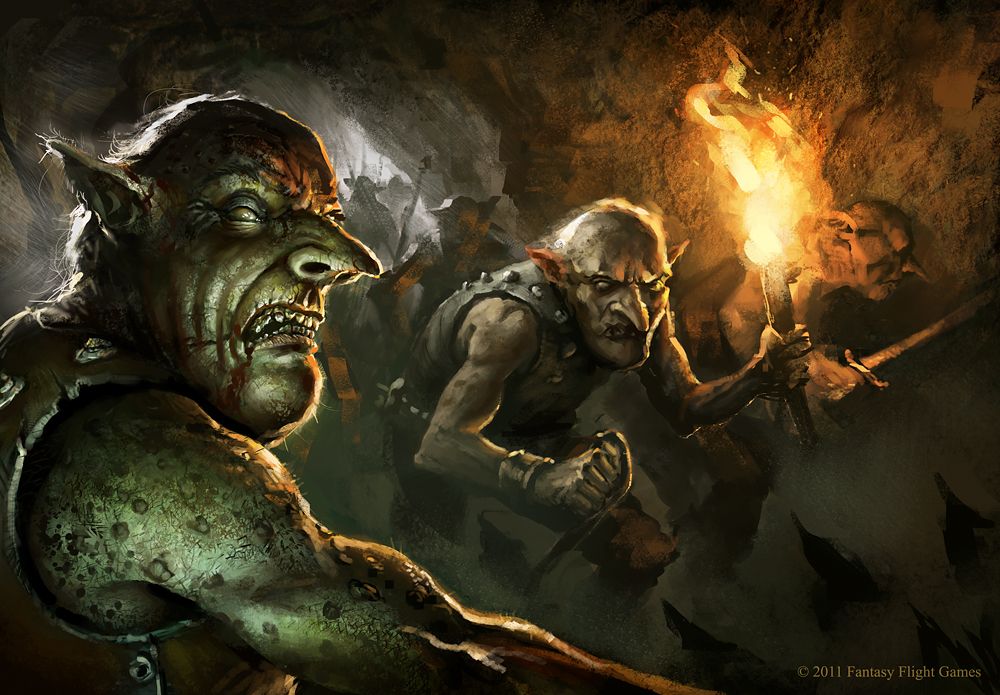Goblin
| Species | humanoid (goblinish) |
| No. Appearing | 5–50 |
| Behaviour | clan |
| Range | barrens, subterranean, steppe, taiga, tundra, woodland |
| Size | 4 ft. tall |
| Weight | 52 lbs. |
| Intelligence | 7–9 |
| Armour Class | 6 |
| Hit Dice | 1 |
| Action Points | 4 |
| Max. Stride | {{{stride}}} |
| THAC0 | 20 |
| Hp/Die | d4 |
| Attack Forms | claw or by weapon type |
| Damage | 1–4, varies |
| Special Attacks | infravision |
Goblins are small humanoids with long, sharp ears, leathery greenish skin and an irascible, cringing nature. They possess a rather unpleasant odour to those who are not of the goblinish race, as they have a distaste for washing themselves. Their intelligence is low, which contributes to their unpleasantness. They have but one homeland, a large, sparsely settled kingdom east of the Ural Mountains that they call Magloshkagok that occupies the lower Ob River basin. The region is mostly taiga, muskeg and gravelled tundra, of little value, that became a refuge for goblin slaves who escaped their hobgoblin masters over the centuries. More than two thirds of the world's population of goblins remain slaves inside hobgoblin lands; or else exist in hidden, subterranean clans scattered throughout Eurasia, from China to Iberia.
History
The first goblins were brought into the world through the Kodar Gate as slaves, first as a part of the hobgoblin Fifty Tribes and later by norkers and xvarts. They were encouraged by these races to increase their numbers, and for this reason were settled in hundreds of slave camps, or gulags, across northern and eastern Asia. For a thousand years, there were tales of goblin clans who escaped to the west, following the Ob River, who were swallowed up by the vast wilderness — or else hunted down and destroyed by hobgoblin war parties. The first settlement of these escaped slaves did not succeed until 663 A.D., with the founding of Gashkura upon a western branch of the Ob River, more than a thousand miles from the hobgoblin frontier. For three centuries thereafter, other settlements were founded, until the goblins were able to form the Magloshkagok kingdom around the large centers of Yobat, Boloine Ob and Istin-gach. These places have grown into important trading markets between east and west.
For centuries before and after this period, goblin mercenaries were used throughout the migration period in which Huns, Slavs, Avars and Magyars swept from the east into Europe. During the rise of human cultures resulting from these invasions, the goblins were persecuted and often exiled; in notable cases, such as Thrace (715 A.D.) and Ruthenia (955), attempts were made to eradicate goblin tribes, who had been granted lands, through genocide. These pogroms forced the goblins into the subterranean realm; there, some tribes have not seen the surface in generations, while other clans willingly raid up to hundreds of miles from their lairs, keeping their origin a secret. There is not a part of Europe or Western Asia that cannot count an unknown number of goblin residents among their populations.
Biology
Goblins reproduce in broods, where usually more than one goblin is born per pregnancy. The brooding period requires 16 to 18 months. Like other goblinish races, goblins are able to safely reproduce healthy offspring from unions between brother and sister — however, such unions often produce only one or two goblins per brood. For that reason, goblins of different clans are exchanged, allowing broods from five to ten per brood. Infant deaths average about 1 in 4 goblins; the remainder will obtain maturity as combatants in just 5-6 years. If unchecked, a single clan of goblins can vastly increase their number of mature combatants more than five-fold in just a few years — but usually, the food supply requires that only some among the clan are allowed to reproduce, and only once or twice in a lifetime.
Goblins possess infravision and have excellent hearing when in the outdoors (penalty of -1 to stealth). They are well-suited to the extremely cold climate of their homeland. Goblins are able to swim from the day they're born.
Behaviour
See Bestiary
